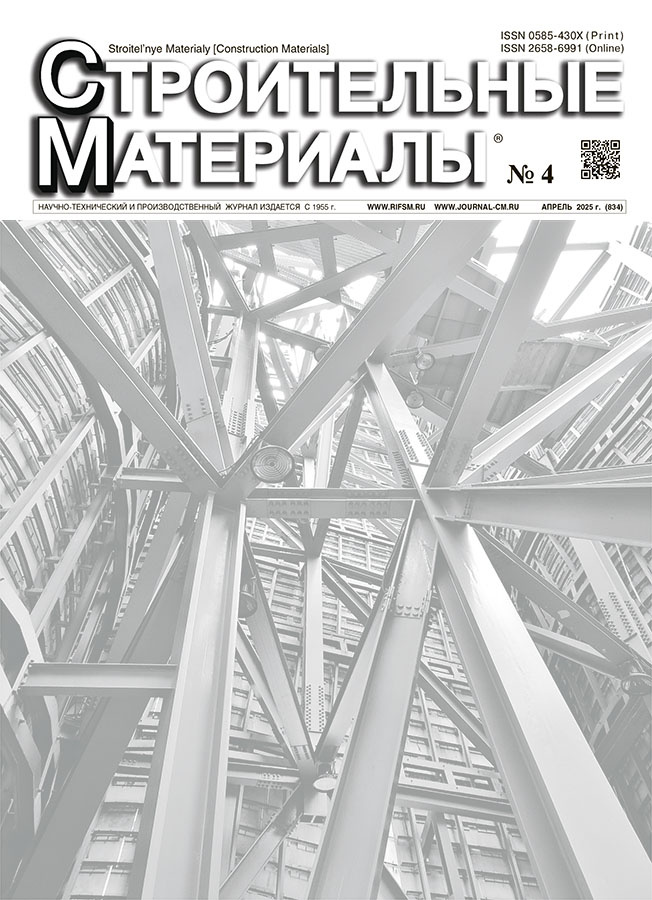Electron microscopy of ceramic materials based on thermal power plant fly ash
- 作者: Stolboushkin A.Y.1, Isterin E.V.1, Fomina O.A.2
-
隶属关系:
- Siberian State Industrial University
- Mechanical Engineering Research Institute of the Russian Academy of Sciences
- 期: 编号 4 (2025)
- 页面: 5-14
- 栏目: Статьи
- URL: https://rjonco.com/0585-430X/article/view/682890
- DOI: https://doi.org/10.31659/0585-430X-2025-834-4-5-14
- ID: 682890
如何引用文章
详细
The importance of studying ceramic materials microstructure for controlling sintering processes which provide ceramic masses required performance characteristics is shown. The scanning electron microscopy (SEM) informativity in carrying out parametric structural analysis of building materials is noted. The physical principles that ensure electron microscopy high resolution and the various optical systems characteristics used in microscopic research methods are given. The samples prepared on modern equipment with application of a conductive layer on their surface were investigated, SEM and energy dispersive spectroscopy (EDS) were carried out using a KYKY EM 6900 electron microscope. Microstructure and features of pore space of the ceramic materials based on thermal power plant fly ash have been studied. A step-by-step procedure for setting up and conducting experiments is described, including study of the matrix structure at microscope resolution different limits, study of the matrix composite nuclei pore microstructure and the sample scanned surface elemental composition. The total elements concentration of EDS spectrum of the ceramic sample based on fly ash is presented. The SEM studies results are described indicating the peculiarities of the ceramic composite matrix structure formation that is a boundary layer forming a transition zone between the matrix and the core of the composite material. Features of the nuclei pore space fiber structure formation with fibers disorderly arrangement and abundance of air spaces between them.
全文:
作者简介
A. Stolboushkin
Siberian State Industrial University
编辑信件的主要联系方式.
Email: stanyr@list.ru
Doctor of Sciences (Engineering)
俄罗斯联邦, 42, Kirova Street, Novokuznetsk, 654007E. Isterin
Siberian State Industrial University
Email: eisterin@gmail.com
Engineer
俄罗斯联邦, 42, Kirova Street, Novokuznetsk, 654007O. Fomina
Mechanical Engineering Research Institute of the Russian Academy of Sciences
Email: soa2@mail.ru
Candidate of Sciences (Engineering)
俄罗斯联邦, 4, Maly Kharitonyevsky Pereulok, Moscow, 101990参考
- Patent RF No. 2835396. Syryevaya smes dlya izgotovleniya stenovykh keramicheskikh materialov i sposob ih polucheniya [The raw material mixture for the manufacture of ceramic wall materials and the method of their preparation]. Stolboushkin A.Yu., Isterin E.V., Fomina O.A. Declared 10.07.2024. Published 25.02.2025. (In Russian). EDN: NMYUME
- Mecholsky J.J. Evaluation of mechanical property testing methods for ceramic matrix composites. American Society-Bulletin. 1986. Vol. 65. No. 2, pp. 315–322.
- Abdrakhimova E.S., Abdrakhimov V.Z. On the use of aluminum-containing nanotechnogenic raw materials in the production of ceramic composite materials. Materialovedeniye. 2014. No. 12, pp. 44–52. (In Russian). EDN: TBSJBL
- Abdrakhimov V.Z., Abdrakhimova E.S. Ceramic wall materials based on fired sludge of alkaline etching of aluminum and intershale clay. Ekologiya Promyshlennogo Proizvodstva. 2015. No. 3 (91), pp. 8–11. (In Russian). EDN: UYCGQB
- Storozhenko G.I., Sebelev I.M., Simonov P.A. Production of wall (facade and effective) ceramics based on mechanically activated loess loams. Izvestiya of Higher Educational Institutions. Construction. 2023. No. 10 (778), pp. 21–34. (In Russian). EDN: CHIIFV. https://doi.org/10.32683/0536-1052-2023-778-10-21-34
- Guryeva V.A., Doroshin A.V., Dubineckij V.V. Ceramic bricks of semi-dry pressing with the use of fusible loams and non-traditional mineral raw materials. Solid State Phenomena. 2020. Vol. 299, pp. 252–257. EDN: UMPXJB. https://doi.org/10.4028/www.scientific.net/SSP.299.252
- Suvorova O.V., Selivanova E.A., Mikhailova J.A., Masloboev V.A., Makarov D.V. Ceramic products from mining and metallurgical waste. Applied Sciences (Switzerland). 2020. Vol. 10. No. 10. 3515. EDN: TGQQOY. https://doi.org/10.3390/app10103515
- Stolboushkin A.Yu., Berdov G.I., Vereshchagin V.I., Fomina O.A. Ceramic wall materials of matrix structure based on non-sintering low-plasticity technogenic and natural raw materials. Stroitel’nye Materialy [Construction Materials]. 2016. No. 8, pp. 19–23. (In Russian). EDN: WMSBOR
- Toturbiev B.D., Mamaev S.A., Toturbiev A.B. Low-fired, energy-saving, environmentally friendly technology for the production of ceramic materials based on clay shale. Geologiya i Geofizika Yuga Rossii. 2022. Vol. 12. No. 1, pp. 148–161. (In Russian). EDN: DSUZVE. https://doi.org/10.46698/VNC.2022.45.82.011
- Vlasov V.A., Skripnikova N.K., Semenovykh M.A., Volokitin O.G., Shekhovtsov V.V. Wall ceramic materials using technogenic iron-containing raw materials. Stroitel’nye Materialy [Construction Materials]. 2020. No. 8, pp. 33–37. (In Russian). EDN: LNTWYG. https://doi.org/10.31659/0585-430X-2020-783-8-33-37
- Ilyina L.V., Tatski L.N., Ulyanova O.V. Modification of low-quality clay raw materials with nanosilica gel and its effect on the properties of ceramic shards. Stroitel’stvo i rekonstruktsiya. 2022. No. 1 (99), pp. 120–133. (In Russian). EDN: UBPYZC. https://doi.org/10.33979/2073-7416-2022-99-1-120-133
- Kotlyar V.D., Kozlov A.V., Zhivotkov O.I., Kozlov G.A. Sand-lime brick based on ash microspheres and lime. Stroitel’nye Materialy [Construction Materials]. 2018. No. 9, pp. 17–21. (In Russian). EDN: XZJALZ. https://doi.org/10.31659/0585-430X-2018-763-9-17-21
- But T.S., Vinogradov B.N., Gavrilova T.I., Gorshkov V.S., Dolgopolov N.N., Myagkova M.A., Sirotkina N.L., Fadeeva V.S. Sovremennyye metody issledovaniya stroitel’nykh materialov [Modern methods of studying building materials]. Moscow: Gosstroyizdat.1962. 238 p.
- Manual of Symbols and Terminology. Pure and Applied Chemistry. 1972. Vol. 31. p. 577.
- Karnaukhov A.P. Adsorbtsiya. Tekstura dispersnykh i poristykh materialov [Adsorption. Texture of dispersed and porous materials]. Novosibirsk: Nauka. 1999. 470 p.
- Tekhnologicheskaya otsenka mineral’nogo syr’ya. Oprobovaniye mestorozhdeniy. Kharakteristika syr’ya: Spravochnik / Pod red. P.Ye. Ostapenko. [Technological assessment of mineral raw materials. Testing of deposits. Characteristics of raw materials: Handbook / Ed. P.E. Ostapenko]. Moscow: Nedra. 1990. 272 p.
- Yakovlev V.V., Kuzmin S.V., Gilmutdinov I.F., Nikitin O.N. Features of the application of scanning electron microscopy and electron probe X-ray spectral microanalysis methods in the study of radioactive materials. Collection of works of JSC “SSC RIAR”. Dimitrovgrad. 2023, pp. 3–11. (In Russian). EDN: FNERPC
- Stolboushkin A.Yu., Isterin E.V. Study of fly ash from the West Siberian Thermal Power Plant as a potential raw material for producing ceramics. Quality. Technologies. Innovations: Proceedings of the VI International Scientific and Practical Conference. Novosibirsk. 2023, pp. 96–103. (In Russian). EDN: PXPAPA
- Stolboushkin A.Yu., Isterin E.V., Fomina O.A. Use of thermal power engineering waste to reduce the average density of ceramic wall materials with a matrix structure. Stroitel’nye Materialy [Construction Materials]. 2024. No. 4, pp. 13–19. (In Russian). EDN: TPRBIP. https://doi.org/10.31659/0585-430X-2024-823-4-13-19
补充文件















